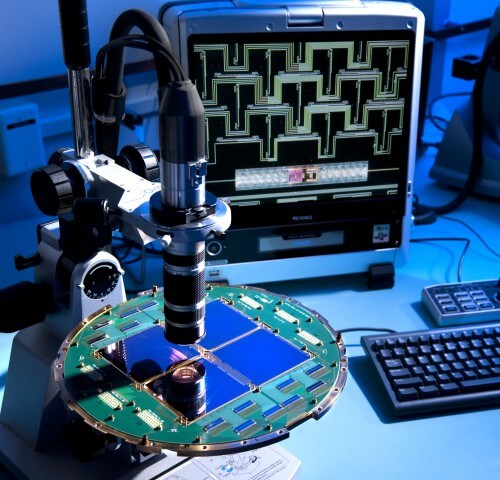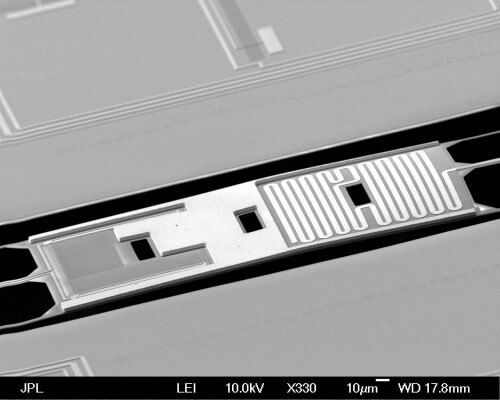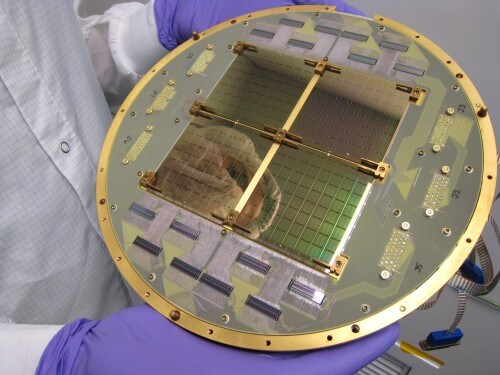NASA reveals details about the detectors made of superconducting materials that helped the discovery that was defined as the most important discovery in astrophysics in the last 15 years

BICEP2 uses a dedicated array of superconducting detectors to pick up polarized light that set out billions of years ago. The array of detectors, visible in the image under magnification under a microscope uses methods of microlithography and micromechanics developed for the device. Photo: NASA/JPL-Caltech
Yesterday we reported on the discovery that they were registered Direct evidence of the gravitational waves that passed through the early universe, created disturbances in it that turned into galaxies following a very accelerated expansion of the universe "swelling or inflation", and interviewed Prof. Avi Leib, head of the Department of Astronomy at Harvard University, director of the Institute for Theory and Computation at the Harvard Smithsonian Center for Astronomy and member of the American National Academy of Sciences and Arts. One of the researchers in his department, Dr. John Kovacs, led the study, which analyzed observations of the cosmic background radiation from the BICEP2 telescope located in an unusual location - the South Pole.
Kovacs and his team announced at a press conference following their paper in Nature that they had discovered the first direct evidence that gravitational waves traversed the embryonic universe as it underwent a process of accelerated growth known as inflation. This is the strongest confirmation yet of the theory of cosmic inflation, according to which the universe expanded 100 trillion trillion times in less than the blink of an eye.
More of the topic in Hayadan:
- NASA and the European Space Agency's large detector to prove Einstein's gravitational waves
- First direct evidence of the existence of gravitational waves that caused the universe to swell immediately after the big bang
Today NASA reveals details about the telescope, which it co-finances and developed some of the technologies used in it. The findings were made with the help of detector technology developed by NASA in the BICEP2 telescope located at the South Pole, in collaboration with the National Science Foundation.

"Activating the most advanced detectors on the ground and in balloons allowed us to improve these technologies and use them in space missions and in the process also make discoveries about the universe" says Paul Hertz, director of the Astrophysics Division at NASA in Washington.
"Our universe burst into existence in an event known as the Big Bang 13.8 billion years ago. Moments later, a fraction of a second to be exact, space itself was torn apart and expanded exponentially in an event known as inflation. Evidence of these chapters in the history of the universe is embedded in our sky, in a dim glow known as the "Cosmic Microwave Background Radiation". Recently, this basic theory about the universe was confirmed by the European Space Agency's Plancked space telescope, for which NASA provides detectors and cooling technologies.
However, researchers have been looking for some time for more direct evidence of inflation in the form of gravitational waves, which compressed and stretched space.
"Tiny quantum fluctuations have been amplified to enormous dimensions by the inflationary expansion of the universe. We know that one of the results of these events are waves of a different type called density waves, but we wanted to examine whether gravity waves were also created," says Jamie Bock from NASA's Jet Propulsion Laboratory in Pasadena and co-director of the project. JPL developed the BICEP2 detector technology. Bock also holds a position at the California Institute of Technology (Caltech), also located in Pasadena.
Gravitational waves created swirling patterns in the polarized light known as "B-mode" polarization. Light becomes polarized when it hits the surface of solid materials such as a car or a pool. Polarized sunglasses repel polarized light to reduce glare. In the case of the cosmic microwave background radiation, the light is repelled by electrons and as a result it becomes slightly polarized.
The BICEP2 team took on the challenge of locating "B-mode" polarization using the best experts in the field and developing innovative technology, and traveling to the best observation site on Earth even if it is at the South Pole. The partnership includes major contributions from Caltech, JPL, Stanford University, Harvard University and the University of Minnesota in Minneapolis.
Following the experiments conducted there since 2006, the team members managed to build the evidence portfolio for the existence of "B-mode" signals, and together with them the strongest support to date for cosmic inflation. The key to their success were the superconducting detectors. Superconductors are materials that, when cooled, allow the current of electrons to flow freely with zero resistance.

"Our technology combines the properties of superconductors with the smallest structures that can be seen through a microscope. These devices are manufactured using the same micromechanical process as the sensors found in cell phones and game consoles such as the Wii," says Anthony Turner, who made these devices in the specialized manufacturing facility at JPL's Micro Devices Laboratory.
"B-mode" signals are very weak. To achieve the sensitivity needed to detect the polarized signals, Bock and Turner developed a unique array of multiple detectors, similar to the pixels in modern digital cameras, but added the ability to detect polarization. The entire detector system operates at a temperature of a quarter of a degree Kelvin, that is, a quarter of a degree above absolute zero, which is the lowest possible temperature.
"These challenging measurements required a completely new architecture," said Bock. "Our approach is like taking a camera and building it in a printed circuit board."
The BICEP2 experiment used 512 detectors, which accelerated the observations of the magical background radiation by 10 times compared to the two previous measuring instruments. The new experiment is already making observations and it includes 2,560 detectors.
These and future experiments will not only help confirm the fact that the universe swelled with enormous light, but will also provide theorists with the first clues about the exotic forces that tore space and time apart.

6 תגובות
Interesting article. Waiting to see talkbacks from readers who are very interested. I did not fully understand why a superconductor is required to discover B polarization modes, but apparently a superconductor is required to see such waves, and even then they are so weak that they probably perform statistics to detect them out of the noise of the signal. The cryogenics (cold) of the detectors to a quarter of a degree Kelvin is a huge technological problem in itself. Liquid nitrogen only cools down to a minimum of about 180 degrees, and here they reached minus 273. That is, the thermal electron noise was reduced to absolute zero or ten to the power of minus something. I don't know of any technology to reach this temperature other than a pressure chamber in a laboratory. What is beautiful is that the Americans, in the absence of the phenomenal budgets that characterized space exploration in space, even so the telescope costs a huge fortune, manage to change their approach and carry out groundbreaking research with a "low" budget.
I was interested in whether the use of string theory was required to understand the inflationary model and I sent a question to Gali. If I have time I will look for the inflation model on the net. If so, this is the first experimental proof of string theory, which was said to have no experimental proofs.